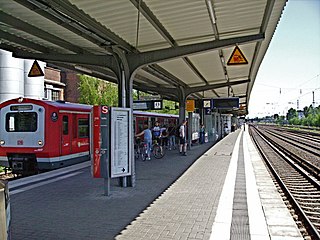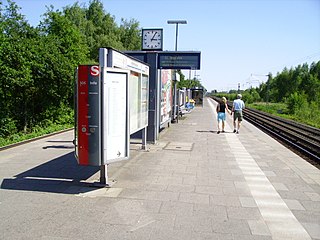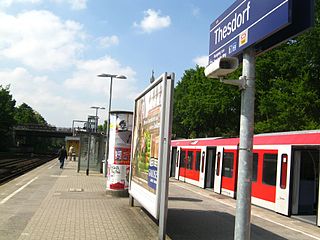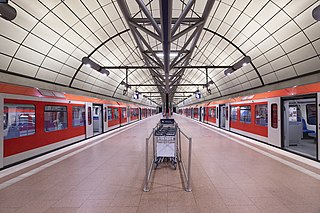
The Hamburg S-Bahn is a rapid transit railway system in the Hamburg Metropolitan Region. Together, the S-Bahn, the Hamburg U-Bahn, the AKN railway and the regional railway form the backbone of railway public transport in the city and the surrounding area. The network has operated since 1907 as a commuter rail system, under the direction of the state railway, and is a member of the Hamburger Verkehrsverbund. There are four lines, serving 68 stations, on 147 kilometres (91 mi) of route. On an average working day the S-Bahn transports about 590,000 passengers; in 2010 about 221 million people used the S-Bahn.

Hamburger Hochbahn AG (HHA), founded in 1911, operates the underground system and large parts of the bus system in Hamburg, Germany. Its name comes from the initial name given to the Hamburg metro system, Hochbahn.

Ellerbek is a municipality in the district of Pinneberg in Schleswig-Holstein in Germany. It consists of the two parts, Ellerbek-Dorf and Neu-Ellerbek.
Transdev Germany is the largest private operator of passenger buses and trains in Germany. It is a subsidiary of Transdev.

Jungfernstieg is an underground railway station in the city centre of Hamburg, Germany, served by the underground railway (U-Bahn) and the suburban railway (S-Bahn). The station is one of Hamburg's busiest rapid transit hubs.

Norderstedt Mitte station is a railway station in Norderstedt, Germany. It is a terminus for the rapid transit trains of the line U1 of the Hamburg U-Bahn and connects the underground railway with the commuter trains of the AKN railway company line A2.

AKN Eisenbahn GmbH operates railway lines, commuter trains and freight trains in Hamburg and Schleswig-Holstein. Its headquarters is in Kaltenkirchen. It is a member of the Hamburger Verkehrsverbund (HVV), which organises public transport in and around Hamburg.

Langenfelde railway station is on the Altona–Kiel and the Altona–Neumünster lines and is served by the city trains. The station is named after the Langenfelde suburb. It is located in the Stellingen quarter in the Hamburg borough of Eimsbüttel, Germany. The station is managed by the DB Station&Service plc. for the public transport operator of Hamburg.

Eidelstedt railway station is on the Hamburg-Altona–Kiel line and is served by the city trains and the commuter trains of the AKN railways plc., located in Hamburg, Germany

Krupunder station is on the Hamburg-Altona–Kiel line and is a railway station served by the city trains of the Hamburg S-Bahn. The railway station is located in the municipality Halstenbek in the district of Pinneberg, in Schleswig-Holstein, Germany, directly at the border to Hamburg.

Thesdorf station is on the Hamburg-Altona–Kiel line and is a railway station served by the city trains of the Hamburg S-Bahn. The railway station is located in the town Pinneberg in the district of the same name, in Schleswig-Holstein, Germany.

Hamburg Airport (Flughafen) is a station on line S1 of the Hamburg S-Bahn, serving Hamburg's airport in the quarter of Fuhlsbüttel in the northeast of the city. It opened in 2008. According to S-Bahn Hamburg GmbH — owner and operator of the S-Bahn — about 13,500 passengers used the service per day in 2009, with an increase to 20,000 daily passengers by 2013. The station's name is identical in both English and German with the English word "airport" being used primarily in both languages and with the German equivalent "Flughafen" added in brackets.
The HADAG is a local public transport company in Hamburg, Germany. It owns and operates passengers ferries across the Elbe River, overseen by and integrated into the network of Hamburger Verkehrsverbund (HVV). In 2013, 10.6 million passenger journeys were made on the HADAG network.
Transport in Hamburg comprises an extensive, rail system, subway system, airports and maritime services for the more than 1.8 million inhabitants of the city of Hamburg and 5.3 million people in the Hamburg Metropolitan Region.

Ohlsdorf is a railway station in Hamburg, Germany, located at the junction of the Hamburg-Altona link line with the Alster Valley line and the Hamburg Airport line in Ohlsdorf, Hamburg near the Ohlsdorf Cemetery.
The Alster Northern Railway or ANB was a non-electrified, single-tracked branch line in northern Germany. It linked the stations of Ochsenzoll in Hamburg-Langenhorn with Ulzburg Süd in the district of Segeberg in Schleswig-Holstein.

Hessische Landesbahn is a regional transport company owned by the German state of Hesse, based in Frankfurt am Main. It provides bus and rail passenger transport services and, to a lesser extent, rail freight services in Hesse and across the state’s borders through its subsidiaries and affiliates.

Kaltenkirchen is a rapid transit station on the Hamburg-Altona–Neumünster railway line, located some 30 kilometres (19 mi) north of Hamburg, in the center of Kaltenkirchen, a town in the German state of Schleswig-Holstein.

Ochsenzoll is a station on the Hamburg U-Bahn line U1. Until 1969, it was the north western terminus of the line. It was opened in July 1921 and is located in Hamburg, Germany, in the quarter of Langenhorn. Langenhorn is part of the borough of Hamburg-Nord.




















